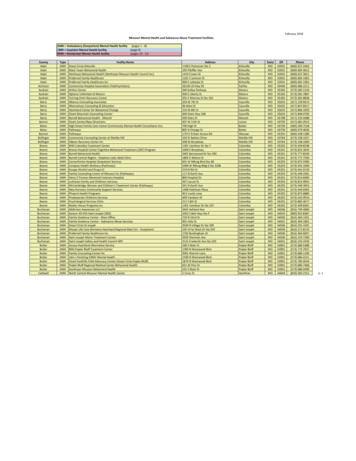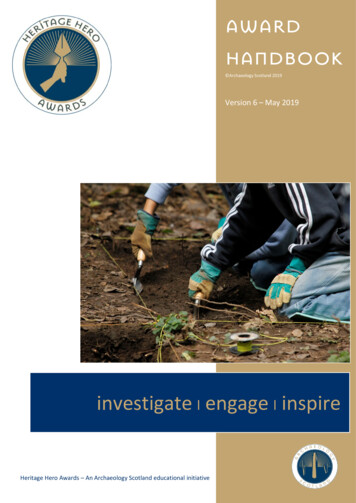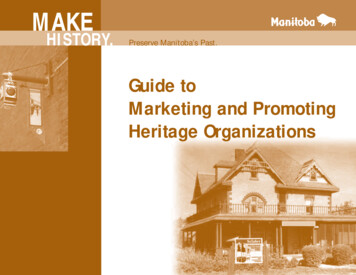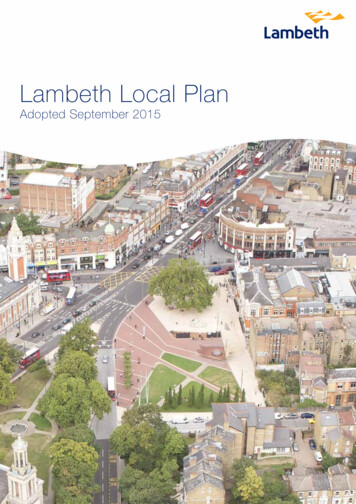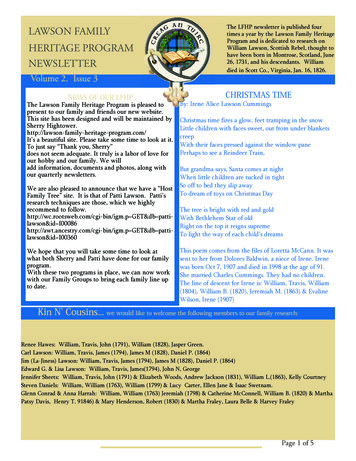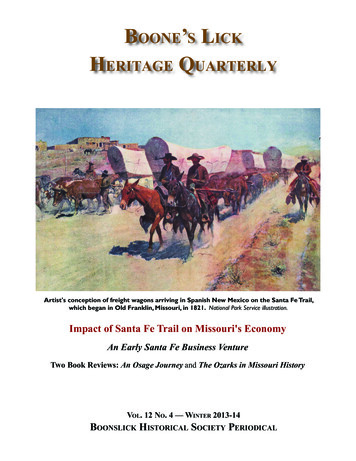
Transcription
Boone’s LickHeritage QuarterlyArtist's conception of freight wagons arriving in Spanish New Mexico on the Santa Fe Trail,which began in Old Franklin, Missouri, in 1821. National Park Service illustration.Impact of Santa Fe Trail on Missouri's EconomyAn Early Santa Fe Business VentureTwo Book Reviews: An Osage Journey and The Ozarks in Missouri HistoryVol. 12 No. 4 — Winter 2013-14Boonslick Historical Society Periodical
EDITOR’S PAGEWagon Tracks and Transcontinental ConnectionsEarly exploration up the Missouri River andHidalgo and subsequently through the Gadsden Purchase infar reaches of the Louisiana Purchase using keelboats, 1853.The more than 800-mile-long Santa Fe Trail also madepirogues and, later on, steamboats hereby acknowledged, thepossibletranscontinental trade connections between theother defining artifacts of nineteenth-century expansion ofUnited States territory, transcontinental trade and migration United States and Spanish Mexico, linking Howard Countyare foot paths, horse trails and wagon tracks etched into but to the latter through the El Camino Real de Terra Adentro,slowly fading from the terra firma. Howard County, Mis- Royal Road of the Interior Lands, that extended south fromsouri, encompasses the geographical intersection of two his- Santa Fe for 1,600 miles to Spain’s colonial capital at Mextoric trails using these land modes of transportation. After ico City. Today, El Camino Real de Tierra Adentro is recogcessation of the War of 1812 and enactment of treaties that nized and maintained by the U.S. Department of Interior as abrought a halt to hostilities from Native Americans in Mis- National Historic Trail. It runs from the Espanola-Santa Fe,souri Territory, much of the push west from east of the Mis- New Mexico, area to El, Paso, Texas, where it originally connected to the Mexican portionsissippi River first followedof El Camino Real. For manythe Boone’s Lick Road/Trailcenturies before the Santa Fefrom St. Charles to FranklinTrail reached New Mexicoin Howard County, startingfrom Missouri, El Caminopoint for the Santa Fe Trail.Real and connecting branchesRecognition of the Boone’sserved tribes of indigenousLick Road as a National Hispeoples as trade routes. Metoric Trail–as with the Santasoamericans sent northwardFe Tail–is being pursued byexotic feathers, live macaws,the Boone’s Lick Road Assocopper bells and shells usedciation, which was establishedto adorn tribal ceremonialin 2011 by Columbia residentdress. Other items commonlyDavid Sapp, who is serving asMap of the Santa Fe Trail from Franklin, Missouri, toexchanged between tribes inits first president.Santa Fe, originally part of Spanish Mexico.Mexico and North AmericaThe start of the Santa Fe(above the Rio Grande River)Trail–initially a trade route–inincludedslaves,salt,animalhides, peyote, minerals, pig1821 at Franklin eventually led to its linkage at the westernmentsandturquoise.Manyofthese artifacts–and much ofedge of Missouri with other historic trails that carried thebulk of migrating Americans westward: the California and this early history–is now presented at the El Camino RealOregon Trails—trails the Mormons also followed partway International Heritage Center Museum (www.elcaminoreal.as they sought final refuge from persecution in the Midwest org) located between Socorro and Truth or Consequences,by settling in the Great Salt Lake Basin of Utah. Preceding New Mexico, along Interstate 25. We recommend a visit.these trails carrying large-scale migration to the West wasthe Santa Fe Trail, a route of commerce and military transport that ultimately did become a way for people to relocateto the Southwest. The economic importance of the Santa FeTrail, especially to the state of Missouri during the early tomid nineteenth century, is documented in the feature article(page 4) by historian Michael Dickey and by a sidebar feature (page 9) by author Lee Cullimore which tells of SantaFe Trail trade expeditions mounted by Boonslick businessman Meredith Miles Marmaduke, who later become governor of Missouri (1844). As a military approach and supplyroute, the Santa Fe Trail also played a key role in the expansion of United States into the Southwest after the MexicanAmerican War of 1846-1848 and the Treaty of Guadalupe2Boone’s Lick Heritage Quarterly Unconscious Faux PasIn the Editor’s Page column for the Fall 2013 issue, weinadvertently moved Daniel Boone’s birthplace from thestate of Pennsylvania to Kentucky. The cultural associationof Boone with Kentucky is a strong and enduring one inAmerican society, thus while writing the Editor’s Page–eventhough we knew better–we subconsciously made him a native son of Kentucky, a cardinal sin—especially since theKentuckians snatched him in death from Missouri for reburial there, which probably would have been against Daniel’slast wishes. Thanks to reader Jim Higbie of Boonville forbringing this editorial faux pas to our attention. We shouldhave been more thorough in our proof reading.– Don B. CullimoreVol. 12, No. 4 Winter 2013-14
Boone’s LickHeritage QuarterlyBoone’s Lick Heritage Quarterly is pub-lished four times a year by the BoonslickHistorical Society, P.O. Box 426, Boonville,MO 65233.We encourage our members and others interested in history to contribute articles or otherinformation of historical interest, includingfamily histories, pertaining to the region. Pleaseaddress all contributions and correspondence related to the periodical to the editor, Don B. Cullimore, 1 Lawrence Dr., Fayette, MO 65248, oremail to: don.cullimore40@gmail.com, phone:660-248-1732. Editorial guidelines may be obtained from the editor. Publication deadlines areFebruary 1 for the March (Spring) issue; May1 for the June (Summer) issue; August 1 for theSeptember (Fall) issue; and November 1 for the(Winter) December issue.The Boonslick Historical Society wasfounded in 1937 and meets several times ayear to enjoy programs about historical topicspertinent to the Boonslick area. Members of theSociety have worked together over the years topublish historical books and brochures and tomark historic sites. They supported the founding of Boone’s Lick State Historic Site, markedthe sites of Cooper’s Fort and Hanna Cole’sFort and have restored a George Caleb Binghampainting of loan to The Ashby-Hodge Gallery ofAmerican Art at Central Methodist University,Fayette, Mo.Membership dues are 15-Individual, 25-Family, 50-Sponsor, 250-Patron, 500Life. The dues year is January through December. Receive our quarterly publication, Boone’sLick Heritage, and attend annual Society eventshighlighting the region’s history. To become amember, send a check made out to the Boonslick Historical Society, P.O. Box 426, Boonville, MO 65233.Officers and Board Members 2013Cindy Bowen, Armstrong, PresidentSam Jewett, Boonville, Vice PresidentPaula Shannon, Boonville, TreasurerTom Yancey, Fayette, SecretaryDon B. Cullimore, FayetteMike Dickey, Arrow RockDenise Gebhardt, GlasgowBill Lay, FayetteBrett Rogers, BoonvilleConnie Shay, FayetteEditorial StaffDon B. Cullimore, EditorCathy Thogmorton, Graphic DesignerBoonslick Historical Society Vol. 12, No. 4 Winter 2013-14ContentsImpact of Santa Fe Trail on Missouri's EconomyBy Michael DickeyPage 4William Becknell,Father of Santa Fe TrailAn Early Santa Fe Business VenturePage 9By Lee CullimoreMeredith Miles Marmaduke,Early Santa Fe Trail Traderand later Governor of MissouriNews in BriefPage 11Boone's Lick Heritage Quarterly IndexPage 13Book ReviewsPage 14— Van Horn Tavern Relocated— Events Calendar— BHS Member’s Book Receives Award— BHS 2014 Membership Fees Due— An Osage Journey— The Ozarks in Missouri HistoryBoone’s Lick Heritage QuarterlyBy 1880, nearly six decadesafter the start of the Santa FeTrail, the "Iron Horse" broughtan end to the historic freightwagon trail.Illustration courtesy of Missouri DNR,Division of State Parks. Vol. 12, No. 4 Winter 2013-143
Santa Fe TrailSpecie, Sweat and Survival:The Impact of the Santa Fe Trail on Missouri’s EconomyBy Michael Dickey, Arrow Rock State Historic SiteDuring the mid-nineteenth century, three greatoverland trails led from Missouri to the far west: the California, the Oregon and the Santa Fe Trails. The first two wereimmigrant trails whereas the Santa Fe Trail was a route ofcommerce. After 1848, the Santa Fe Trail did carry emigranttraffic but it was still first and foremost a commercial traderoute. Missouri Governor John Miller emphasized the importance of the trade in 1830: “Our trade to the northern partsof New Mexico continues to be prosecuted by our citizensand is an essential and important branch of the commerce ofMissouri.”1 The idea of commerce between Santa Fe and theMississippi valley predates 1821, the official beginning ofthe Santa Fe Trade. Itinerant French traders from the IllinoisCountry reached Santa Fe sporadically throughout the eighteenth century. The Mallet brothers made the most seriousattempt in 1739, but lost most of their trade goods in a rivercrossing.2 Spanish officials were suspicious of foreignersand the French traders faced confiscation of their property,arrest and expulsion. Consequently none of these venturesresulted in the establishment of regular commerce.At the conclusion of the French and Indian War in 1763,France ceded the vast Louisiana Territory to Spain. Spanishdominion now stretched from New Mexico to the Mississippi River. Trade between Santa Fe and the new town ofSt. Louis appealed to some officials. The Governor of NewMexico sent Pedro Vial from Santa Fe to St. Louis in 1792with the express purpose of opening a trade route. However,the Spanish government did not capitalize on his success.Spain still feared that trade would invite unwanted foreigninfluence into New Mexico, as the inhabitants of St. Louiswere of French and now increasingly, American extraction.3When the United States purchased the Louisiana Territory in 1803, interest in trade with Santa Fe was renewed.William Morrison of Kaskaskia, Illinois, sent Jean BaptisteLaLande to Santa Fe with anunspecified amount of goods.LaLande apparently sold thegoods but failed to return toKaskaskia with the profits.4St. Louis fur trader ManuelLisa eyed the possibilities oftrade with Santa Fe, but uponhearing the reports of theLewis and Clark expeditionturned his attention to the furtrade of the upper Missouri.5The exploration of theSouthwest by Lt. ZebulonGov. John MillerPike in 1806-1807 againMissouri State Archivespiqued American interest inSanta Fe.6 Spain continued its policy of isolation. Almostprophetically, they feared that American colonists wouldfollow American traders resulting in the annexation of NewMexico. Like the French before them American trappers andtraders entering New Mexico were subject to arrest, expulsion and the confiscation of their goods.In 1809, Emmanuel Blanco led St. Louis traders JamesMcLanahan, James Patterson and Ruben Smith to NewMexico. The party was imprisoned until early in 1812. InApril of that year, another trading party under Robert McKnight left St. Louis for Santa Fe. The party was imprisoneduntil 1820 and did not return to St. Louis until the spring of4Vol. 12, No. 4Boone’s Lick Heritage Quarterly Winter 2013-14
Santa Fe Trail1821. When they got home, they described their ordeal, theirdisappointment in the government’s half-hearted efforts tofree them, but most importantly they speculated about theprospects of future trade in Santa Fe.7The conclusion of the War of 1812 and the subsequentpeace with Britain’s Indian allies opened the way for aflood of emigration into the wilderness of central Missouri’s“Boonslick Country.” Towns literally sprang up in the wilderness overnight. The largest of these was Franklin, founded in 1816 on the banks of the Missouri River. By 1819, thetown was second only in size to St. Louis and was the hubof trade, industry and commerce in the Boonslick Country.It was destined to play a crucial role in the development ofthe Santa Fe trade.Excessive land speculation in the western states and territories led to price inflation by 1819. Nearly everyone wasin debt as people rushed to buy on credit. Land was sold andresold over and over without actual payments being made.Finally, the bubble broke and the economy collapsed. Theresulting depression known as the “Panic of 1819” was feltin Missouri Territory by the latter half of 1820. Emigrationto the Boonslick Country halted, land was no longer marketable and farm produce had no buyers. Gold and silver coinor “specie” fled the country and prices fell. Merchants wentbankrupt and many of the frontier boomtowns went bust,even disappearing off the map. Banks produced their ownnotes but most were unredeemable which led Missourians todistrust banks and their “soft money.” Existing banks failedand no new banks were established in Missouri for anotherseventeen years.8In this atmosphere of despair, one man in Franklin tookdesperate action to stave off prosecution for his debts. William Becknell took out an ad in the July 25, 1821, issue ofthe Missouri Intelligencer newspaper. It read in part, “An article for the government of a company of men destined to thewestward for purposes of trading for Horses and Mules, andcatching Wild Animals of every description, that we thinkadvantageous to the company.”9 Each man was to stake 10.00 worth of merchandise for the trip. The ad was a firststep in what would become the first successful trading venture to Santa Fe with lasting economic consequences.Becknell and several others with packhorses crossed theMissouri River near the Arrow Rock ferry on September 1,1821. The expedition coincided with two events that wouldfacilitate and foster regular trade between Santa Fe and theBoonslick Country: the admission of Missouri as a state andthe establishment of Mexico as an independent republic.In contrast to earlier adventurers arriving in New Mexico,Becknell reported that on November 13th, “ we had thesatisfaction of meeting a party of Spanish troops. Althoughthe difference in language would not admit to conversation,Boone’s Lick Heritage Quarterlyyet the circumstances attending their reception of us, fullyconvinced us of their hospitable disposition and friendlyfeelings.”10 Becknell also reported that the Governor ofSanta Fe “ expressed a desire that the Americans wouldkeep up an intercourse with that country ”11Approximately two weeks after Becknell’s arrival, St.Louis Merchants Thomas James and John McKnight arrivedin Santa Fe via the Arkansas River. McKnight was primarily interested in finding his brother Robert who had failedto return from an ill-fated trade expedition of 1812. Jameshowever sought to dispose of surplus goods. Shortly afterthem, the Glenn-Fowler party, which had been trapping inthe mountains, came into Santa Fe and did some trading.Becknell recognized the opportunity at hand and returned to Franklin in January of 1822 planning a return tripfor the sole purpose of carrying trade goods to SantaFe. Mr. H.H. Harris reminisced about Becknell’s return. “My father saw themunload when they returned,and when their rawhidepackages of silver dollarswere dumped on the sidewalk, one of the men cutthe thongs and the moneyspilled out clinking on thestone pavement and rolledinto the gutter.”12 If the acWilliam Becknellcount is true, this wouldIllustration, BHS Archiveshave been an electrifyingsight in economically depressed Franklin. In the spring of 1822, three trading expeditions left Franklin bound for Santa Fe. Becknell’s party tookthree wagons loaded with goods, the first of many wheeledconveyances to be used on the trail.New Mexico’s policy towards foreign traders hadchanged for several reasons. Spain had consumed the rawresources of the province while returning little to the inhabitants in the way of finished goods. The economic poverty ofthe people was exacerbated by the official policy barring foreign traders. With independence, New Mexicans were nowfree to utilize their own resources to purchase manufacturedgoods. For example, the silver mines within forty miles ofSanta Fe could now benefit the local populace instead of justthe ruling elite in Madrid, Spain.Conversely, economically depressed Missouri finallyhad an outlet for the surplus merchandise that had accumulated as a result of the Panic of 1819. Geography andtopography also fostered the growth of trade. The distancefrom Franklin to Santa Fe was about 800 miles and the Great Vol. 12, No. 4 Winter 2013-145
Santa Fe TrailPlains was a relatively easy course to travel for most of thedistance. This contrasted sharply with Vera Cruz, Mexico’sofficial port of entry. It was nearly 2,000 miles from VeraCruz to Santa Fe, all of it over rough and mountainous terrain.The Boonslick Country being at the westernmost edgeof American settlement was naturally poised to advantage ofthe new trade relations. Josiah Gregg reported in 1844 that,“The town of Franklin onthe Missouri River seemstruly to have been the cradleof our trade: and in conjunction with several neighboring towns continued to furnish the greater number ofthese adventurous traders.”13Records indicate that someresidents of Columbia, Boonville, New Franklin, Fayette,Glasgow, Jonesboro (Napton)and Arrow Rock had investments and connections withthe Santa Fe trade well intothe 1850s.Josiah GreggFor the first six years orBHS Archivesso, two thirds of the men onthe Santa Fe Trail owned their own trading goods. Theywere not necessarily involved in the trade full time andfound it beneficial to sandwich a trip to Santa Fe betweenother enterprises, typically leaving in the early spring whentraveling conditions across the Plains were optimal. Missouri merchants were the middlemen for goods purchasedfor the trade, usually at a 20- to 30-percent markup overPhiladelphia prices. From the mid-1820s through the 1830s,St. Louis, Franklin and Independence merchants commonlyadvertised new shipments of goods in terms such as “expressly for the Santa Fe market.”14From 1822 to 1827, the yearly amount of merchandisetaken to Santa Fe was approximately 50,000 in eastern prices. From 1838 to 1843 the amount of merchandise exportedwas approximately 200,000 annually.15 In 1824, Franklintrader Augustus Storrs reported that this merchandise consisted of “Cotton goods, consisting of course and fine cambrics, calicoes, domestic shawls, handkerchiefs, steam-loomshirtings, and cotton hose. A few woolen goods, consistingof super blues, stroudings, pelisse cloths and shawls, crapes,bombazettes, some light articles of cutlery, silk shawls andlooking glasses.”16Twenty years later, these types of goods still composedthe bulk of trade items. Josiah Gregg in 1844 advised tradersthat at least half of a “Santa Fe assortment” should be madeup of domestic cottons and about equally divided between“bleached and brown” with a fourth of the assortment to becomposed of calicoes and miscellaneous articles composethe rest of the cargo.17While Missouri benefited most directly from the trade,clearly the cotton growing states in the South and textilemilling states in New England derived some benefit as well.Missouri politicians many times used this wider appeal ofthe trade in hopes of gaining federal legislative and militaryprotection of the trade. They constantly sought “drawbacks,”the elimination of taxes and tariffs on items imported for usein the Santa Fe trade. Maritime commerce frequently benefited from “drawback” legislation and Missourians simplysaw the Santa Fe trade as a logical extension of that protection.The principal articles that were returned to Missouriwere furs, livestock, specie and small amounts of raw wool.Coarse Mexican blankets were occasionally in demand onthe frontier.18 In some respects, the early Santa Fe tradewas an off shoot of the fur trade. “Catching wild animals”or trapping had been one of the original reasons cited byBecknell’s party for going west. The Glenn-Fowler expedition had returned to Missouri with beaver fur. Independenttrappers operating in the southern Rocky Mountains usedSanta Fe as a base of operations. For the first fifteen yearsof the trade, many returning caravans carried quantities ofbeaver and otter pelts. Plains Indian tribes sold raw buffalorobes to the New Mexicans, who in turn prepared them asrobes for the Santa Fe trade. In 1843, Simeon Turley in Arroyo Hondo, New Mexico wrote to his brother Jesse in Arrow Rock, Missouri that he was shipping him “200 buffalorobes and a load of beaver.”19Of greater long-term consequence to Missouri was thelivestock, consisting of horses, jacks, jennets, and mules. Asearly as 1823, the Cooper family of Howard County broughtback over four hundred mules to Missouri. Those numbersincreased in 1825 to 600 mules, in 1827 to 800 mules and in1832 over 1,300 mules.20 Missourians began crossing Mexican jacks with the fine mares they had brought with themfrom Kentucky and Tennessee thus establishing the muleindustry in Missouri. By the 1850s, “Missouri mules” werewidely shipped to the southern states for the use on the cotton plantations. Although large European jacks were beingbred by this time, the mule industry clearly had its roots inthe Santa Fe trade. By 1880 Missouri was the nations leading mule-producing state.The importation of Mexican specie and bullion profoundly impacted Missouri’s economic stability, far morethan the importation of furs or livestock. There are no official statistics on the amount of bullion or specie importedinto the state: traders fearing competition were reluctant to6Vol. 12, No. 4Boone’s Lick Heritage Quarterly Winter 2013-14
Santa Fe Trailreport their profits. Letters from traders frequently reportedpoor conditions in the trade. “This trade is done as all willinform you” said one letter in the Franklin Missouri Intelligencer.21 The paper was quick to declare that the writer wasa man with no motive for misrepresentation. Another letterpublished in 1825 read in part, “On the whole it appears thatthere is little prospect of successful trade being kept up between the United States and this Province, except on a verylimited scale indeed. The country has but few resources They are very poor but very contented.”22The Missouri Advocate, a St. Louis paper criticized theIntelligencer for belittling what was obviously an importantindustry to Missouri. The editor of the Intelligencer replied,“Our own citizens were the first to explore the route andfind the market, and in our opinion, ought to reap the advantages resultingfrom the discovery.We have generallystated plain matters of fact, in regard to this trade,abstaining from allunnecessary embellishments or exaggeration, whichcould only have atendency to attractthe attention of theother states, and induce large bodies to engage in it, to the injury of our owncitizens and the annihilation of the commerce by the gluttingof the market.”23 The Advocate got the point and to protectMissouris interests also began printing articles describingthe “ruinous embarrassments” of the Santa Fe trade.The market in Santa Fe itself did in fact become saturatedrather quickly. However traders often took their goods intothe interior states of Chihuahua, Sonora or Coahila merelyusing Santa Fe as the port of entry. Often they acted in partnership with or sold to Mexican firms who in turn conveyedthe goods in the interior Mexican states. As early as 1826,Mexican merchants began coming to Missouri to purchasetrade goods directly. The Franklin Missouri Intelligencer reported, “Six or seven substantial built waggons [sic] arrivedin this place on Tuesday last, heavily laden with merchandise, on their way to new Mexico owned by Mr. Escudero, anative of that country This may be considered as a new erain the commerce between Mexico and this country, and it isprobable the example of Mr. E. will be followed by others ofhis rich countrymen who will bring hither large portions oftheir surplus wealth for the same purpose.”24 Josiah Greggreported that by 1843, over half of the merchants in the tradeBoone’s Lick Heritage Quarterlywere Mexican nationals.25 Regardless of who conducted thetrade caravans, the Missouri economy was being enriched.Profit margins for the traders fluctuated greatly. Likeall business endeavors, there were setbacks, losses and cyclical variations in the market. Mexico often imposed hightariffs on wagons arriving in Santa Fe, cutting into profits.American Indian tribes sometimes struck caravans, especially those returning with livestock. Trader Meredith MilesMarmaduke, later a governor of Missouri, lost nearly all ofhis investment in 1828 when Comanches stole the livestockhe was returning to Missouri.26 (see article, page 10) However, despite such individual losses, the trade overall grewin profitability.Alphonso Wetmore estimated that Becknell’s second expedition made a profit of 2000 percent. In 1824, 35,000 worth ofmerchandise netted 200,000 for aprofit of 300 percent. In 1832, Secretary of War LewisCass provided theSenate with a reportestimating the profitmargin of the tradeaveraging from 25to 100 percent, dependent on conditions.27 That sameyear, Governor Miller reported that the trade, “ is believedto yield a greater gain than any other branch of industry employing the same amount of capital.”28As early as 1828, Governor Miller had stated, “Thattrade [Santa Fe] is one of much importance to this State; theprincipal part of the silver coin in circulation, particularlyin the western part of the State, is derived from that quarter ”29 Spanish and Mexican coin continued to be legaltender in Missouri long afterwards. For example, in 1840Dr. Glenn O. Hardeman was charged a “bit” or 12 ½ cents inMexican coin for a nights stay in the Arrow Rock Tavern.30In 1824, Franklin merchant Augustus Storrs estimatedthe value of bullion and coin from Mexico at 180,000 andfurs worth 10,000. Secretary of State Eaton reported profits from the Santa Fe Trade to include “at least 200,000in specie.”31 William Bent brought back 100,000 in coinin 1832 and similar amounts were reported in the MissouriIntelligencer for the next three years.32 Most of this moneyremained within the coffers of individuals or businesses.By 1836, Missourians were demanding the creation of abank in the state. The Bank of Missouri opened its door in1837 as a specie-paying bank, refusing to issue paper notes Vol. 12, No. 4 Winter 2013-147
Santa Fe Trailas many previously failed banks had done. It was soon rec- went out from Kansas City alone and the total value of theognized as one of the soundest banks in the nation and served trade was estimated at 5,000,000. The Civil War seems toas a bank of deposit for the United States Government. The have created only a minor disruption to the trade. Colonelbank with headquarters in St. Louis and branches in Fayette J.F. Meline who was touring New Mexico in 1866 said, “Inand Palmyra had intimate ties with the Santa Fe trade. The 1865 there came into New Mexico from the States three thoubank served as a place of deposit for the traders and simpli- sand wagons belonging to traders alone exclusive of governfied commercial transactions between the traders, merchants ment transportation. This year there will be from five to sixand eastern wholesalers. In 1839, a run on the bank was thousand wagons Most of the large trains return empty.”35staved off when Santa Fe traders pumped 45,000 of specie These caravans were supplying United States military postsinto it.33 The Arkansas Gazette reported: “The state of Mis- and the new American settlements in the southwest rathersouri is at this day the soundest in the Union in her monetary than trading with a foreign nation as in years past.affairs. She is filled with specie; and the interior MexicanDespite this phenomenal post-war growth, the singu34states have supplied it.”lar importance of the Santa Fe trade to Missouri was in factBy 1829, Franklin had largely been washed away by declining. The state’s post-war agricultural and industrialthe Missouri River and direct Boonslick involvement in the production had diversified and grown to the point that thetrade gradually began toSanta Fe trade no longerwane. By 1831, Indepenhad a singular dynamic imdence was the main outpact on the state’s economy.fitting center for Santa FeThe burgeoning cities of St.commerce and after 1843;Louis and Kansas City wereWestport increasingly asscarcely the specie starvedsumed that role. ConcurBoonslick towns of fortyrently, with this geographicyears earlier. Furthermore,change in outfitting points,trail heads and outfittingthe nature of the trade itselfpoints followed the advancbegan to change. The numing line of the railroadsber of individual proprietorsacross Kansas, annually dedecreased while the numbercreasing both the length ofof men employed in carathe Santa Fe Trail and orthvans as teamsters, huntersamount of Missouri comor salesmen increased. The side of Arrow Rock State Historic Site. Photo by David Sappmerce carried on it.traders’ average per capitaTechnology and transinvestment of goods rose from 3,000 in 1829 to 6,000 in portation spelled the end of the trade. In August 1867 this1839 and to 15,000 in 1843.editorial appeared in the Junction City Union, “A few yearsIn conjunction with the brokering services provided by ago the freight wagons and oxen passing through Councilthe Bank of Missouri, the larger traders hired agents to pur- Grove were counted by thousands, the value of merchandisechase directly from wholesalers in Philadelphia. Rural Mis- by millions. But the shriek of the iron horse has silencedsouri merchant began to be cut out of the Santa Fe trade. the lowing of the panting ox and the old Trail looks desoEven though they were no longer conducting the wagon late. The track of commerce of the plains has changed andcaravans themselves, many Boonslick residents continued with the change is destined to come other changes and moreto invest ca
Two Book Reviews: An Osage Journey and The Ozarks in Missouri History. 2 Boone’s Lick Heritage Quarterly Vol. 12, No. 4 Winter 2013-14 EDITOR’S PAGE – Don B. Cullimore Early Exploration up thE Missouri rivEr and far reaches of the Louisiana Purchase using keelboats, pirogu


